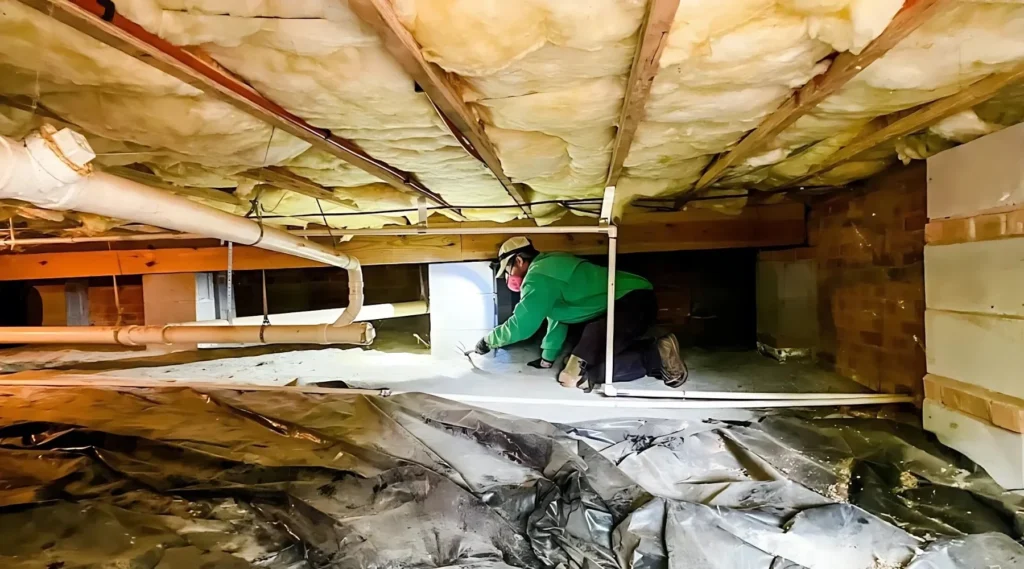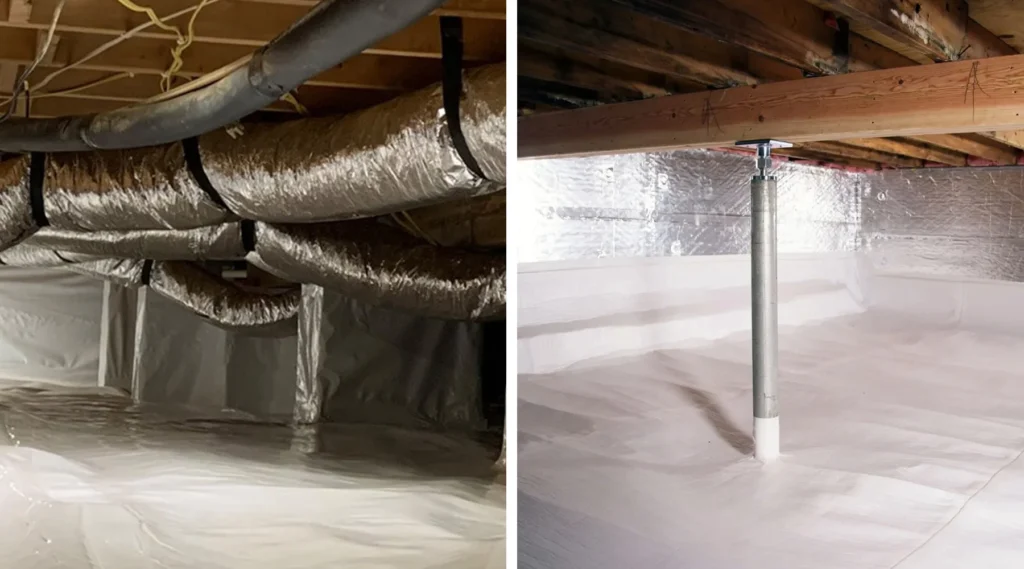Crawl space moisture problems are among the most common yet overlooked issues facing homeowners today. What starts as a minor dampness concern can quickly escalate into severe structural damage, health hazards, and costly repairs. At Tri-State Waterproofing, we’ve been diagnosing and solving crawl space moisture problems for over 23 years across Georgia, South Carolina, and North Carolina.
Understanding the causes, recognizing the warning signs, and knowing how to fix crawl space moisture problems can save you thousands of dollars and protect your family’s health. This comprehensive guide will walk you through everything you need to know about crawl space moisture issues.
Crawl Space Moisture Problems
Due to their location and design, crawl spaces are particularly vulnerable to moisture problems. These semi-enclosed areas beneath your home create the perfect environment for moisture accumulation when not properly maintained or protected.
Why Crawl Spaces Are Prone to Moisture
- Ground-level positioning exposes them to soil moisture
- Limited ventilation can trap humid air
- Temperature fluctuations create condensation
- Direct contact with foundation walls allows water infiltration
- Proximity to plumbing and HVAC systems increases leak risks
What Causes Moisture In The Crawl Space?
Moisture can enter your crawl space in several ways, often due to common construction or environmental factors. Here are some of the most frequent causes to watch out for:
1. Poor Drainage and Water Infiltration
Foundation Water Issues:
- Inadequate exterior drainage systems
- Clogged or damaged gutters and downspouts
- Poor grading that directs water toward the foundation
- Hydrostatic pressure from saturated soil
Foundation Cracks and Gaps:
- Settlement cracks in foundation walls
- Gaps around utility penetrations
- Deteriorated mortar joints
- Expansion joint failures
2. High Humidity and Condensation
Environmental Factors:
- Georgia’s naturally high humidity levels
- Poor air circulation in enclosed spaces
- Temperature differences between the crawl space and outside air
- Seasonal humidity fluctuations
Condensation Sources:
- Cold water pipes create surface condensation
- HVAC ducts without proper insulation
- Uninsulated crawl space walls
- Metal surfaces in humid environments
3. Plumbing and HVAC System Issues
Common Leak Sources:
- Aging or damaged water supply lines
- Leaking drain pipes and connections
- HVAC condensate drain problems
- Water heater leaks or failures
- Washing machine drain issues
4. Ground Moisture and Vapor Transmission
Soil-Related Moisture:
- High water table levels
- Capillary action draws moisture upward
- Unsealed dirt or gravel floors
- Poor vapor barrier installation
- Seasonal groundwater fluctuations
5. Structural and Design Problems
Ventilation Issues:
- Inadequate or blocked crawl space vents
- Improper vent placement
- Conflicting ventilation strategies
- Sealed crawl spaces without proper moisture control
Warning Signs of Crawl Space Moisture Problems
Moisture issues often go unnoticed until they cause visible damage. Here are some key warning signs that your crawl space may have a moisture problem:
Immediate Visual Indicators
Visible Water and Dampness:
- Standing water or puddles
- Wet surfaces
- Water stains on walls or floors
- Efflorescence (white, chalky deposits) on masonry
Mold and Mildew Growth:
- Black, green, or white fuzzy growth
- Discoloration on wood surfaces
- Mold on insulation materials
- Mildew on stored items
Structural Warning Signs
Wood Damage:
- Soft, spongy, or rotting wood
- Sagging or warped floor joists
- Cupping or buckling hardwood floors above
- Loose or squeaky floorboards
Foundation Issues:
- New or expanding cracks
- Crumbling mortar or concrete
- Bowing or leaning walls
- Settlement indicators
Environmental and Health Indicators
Air Quality Problems:
- Persistent musty or earthy odors
- Increased allergy symptoms
- Respiratory irritation
- Worsening asthma conditions
Humidity and Comfort Issues:
- High indoor humidity levels (above 60%)
- Condensation on windows
- A clammy or sticky feeling indoors
- Difficulty maintaining comfortable temperatures
Energy and Performance Signs
HVAC System Strain:
- Increased energy bills
- Frequent HVAC repairs
- Poor heating and cooling performance
- Excessive runtime of climate control systems
Insulation Problems:
- Wet or compressed insulation
- Falling or sagging insulation
- Reduced insulation effectiveness
- Ice dams in winter
How Crawl Space Moisture Affects Your Home
Crawl space moisture doesn’t just stay below your home—it can impact your health, comfort, and property value. Here’s how excess humidity can affect your entire home:
Health Impacts
Indoor Air Quality: Research shows that up to 50% of the air in your home comes from your crawl space. Moisture problems can introduce:
- Mold spores and allergens
- Volatile organic compounds (VOCs)
- Dust mites and other allergens
- Bacterial contamination
Respiratory Health Risks:
- Asthma trigger activation
- Allergic reactions
- Respiratory infections
- Long-term lung health concerns
Structural Consequences
Foundation Damage:
- Concrete deterioration
- Masonry damage
- Settlement issues
- Structural instability
Wood Structure Problems:
- Rot and decay
- Insect infestations (termites, carpenter ants)
- Weakened support systems
- Floor stability issues
Financial Impact
Immediate Costs:
- Higher energy bills (10-30% increase typical)
- HVAC system strain and repairs
- Dehumidifier operation costs
- Emergency water damage repairs
Long-term Expenses:
- Structural repair costs
- Foundation stabilization
- Complete crawl space renovation
- Decreased home value
Professional Diagnosis of Crawl Space Moisture Problems
Identifying the root cause of crawl space moisture requires a thorough inspection. Here’s how professionals assess the problem to recommend the right solution:
Comprehensive Moisture Assessment
At Tri-State Waterproofing, our diagnostic process includes:
Visual Inspection:
- Complete crawl space examination
- Identification of moisture sources
- Structural integrity assessment
- Documentation of problem areas
Moisture Testing:
- Humidity level measurements
- Moisture meter readings on surfaces
- Water intrusion testing
- Air quality sampling when needed
Drainage Evaluation:
- Exterior drainage assessment
- Grading and water flow analysis
- Gutter and downspout inspection
- Foundation perimeter evaluation
How To Fix Moisture Problems In The Crawl Space?
Fixing crawl space moisture issues involves more than just drying things out. Here are the most effective solutions to eliminate moisture and prevent it from coming back:
Immediate Emergency Solutions
Water Removal:
- Pump out standing water
- Set up temporary dehumidification
- Remove wet materials and debris
- Establish emergency ventilation
Source Control:
- Stop active leaks immediately
- Redirect surface water away from the foundation
- Cover exposed soil temporarily
- Address urgent structural concerns
Comprehensive Moisture Control Solutions
To protect your crawl space long-term, you need more than a quick fix. Here are proven, comprehensive solutions that tackle moisture at the source:
1. Crawl Space Waterproofing
Interior Waterproofing Systems:
- Drainage Systems: French drains and collection systems
- Sump Pump Installation: Automatic water removal systems
- Crack Injection: Permanent crack sealing solutions
- Interior Coatings: Moisture-resistant wall treatments
Exterior Waterproofing:
- Foundation Sealing: Complete exterior waterproofing
- Drainage Improvements: Proper grading and drainage
- Gutter Systems: Effective water management
- Landscaping Solutions: Strategic water diversion
2. Crawl Space Encapsulation
Step 1: Preparation
- Remove debris and damaged materials
- Address any structural issues
- Install necessary drainage systems
- Repair foundation cracks
Step 2: Vapor Barrier Installation
- High-quality 6-mil or thicker vapor barriers
- Complete floor coverage with sealed seams
- Wall coverage to the appropriate height
- Proper attachment and sealing methods
Step 3: Sealing and Insulation
- Seal all vents and openings
- Insulate rim joists and band boards
- Install proper wall insulation
- Seal around all penetrations
Step 4: Climate Control
- Install dehumidification systems
- Establish proper air circulation
- Connect to the home’s HVAC system if appropriate
- Monitor and control humidity levels
3. Drainage and Water Management
Foundation Drainage:
- Install or repair foundation drains
- Improve exterior grading
- Add drainage systems around problem areas
- Maintain proper water flow away from the foundation
Surface Water Control:
- Gutter and downspout improvements
- Splash blocks and extensions
- Landscape drainage solutions
- Permeable paving where appropriate
4. Ventilation Solutions
Traditional Ventilation:
- Proper vent sizing and placement
- Cross-ventilation establishment
- Seasonal vent management
- Mechanical ventilation when needed
Conditioned Crawl Space Approach:
- Complete sealing of all vents
- Integration with the home’s HVAC system
- Controlled air exchange
- Continuous moisture monitoring
Preventive Maintenance for Crawl Space Moisture Control
Keeping your crawl space dry requires regular care. Here are some preventive maintenance steps to help you avoid future moisture problems:
Regular Inspection Schedule
Monthly Checks:
- Visual inspection for new moisture signs
- Humidity level monitoring
- Check the dehumidifier operation
- Inspect for pest activity
Seasonal Maintenance:
- Spring: Check for winter damage and prepare for the humid season
- Summer: Monitor peak humidity performance
- Fall: Prepare systems for temperature changes
- Winter: Prevent freezing and maintain proper operation
Annual Professional Inspections:
- Comprehensive system evaluation
- Equipment maintenance and calibration
- Vapor barrier integrity check
- Drainage system cleaning and testing
Ongoing Moisture Prevention
Exterior Maintenance:
- Keep gutters and downspouts clean
- Maintain proper grading around the foundation
- Trim vegetation away from the foundation
- Monitor and repair exterior cracks promptly
Interior Monitoring:
- Maintain dehumidifier systems
- Monitor humidity levels regularly
- Address plumbing leaks immediately
- Keep the crawl space clean and organized
Choosing the Right Contractor
Key Qualifications to Look For:
- Proper licensing and insurance
- Specialized crawl space experience
- Quality references and reviews
- Comprehensive warranty offerings
- Advanced equipment and techniques
Why Choose Tri-State Waterproofing:
- 23+ Years of Experience: Proven expertise since 2000
- BBB A+ Rating: Commitment to quality and customer satisfaction
- HomeAdvisor Screened: Verified and trusted contractor
- Comprehensive Solutions: Complete moisture control systems
- 100% Satisfaction Guarantee: Stand behind our work
- Flexible Financing: Making solutions affordable
Conclusion
Crawl space moisture problems are serious issues that require prompt, professional attention. Understanding the causes, recognizing the warning signs, and implementing comprehensive solutions can protect your home’s structural integrity, your family’s health, and your financial investment.
Don’t wait for moisture problems to escalate into costly disasters. Early intervention with proper waterproofing, Encapsulation, and moisture control systems can save thousands of dollars and provide lasting protection for your home.


